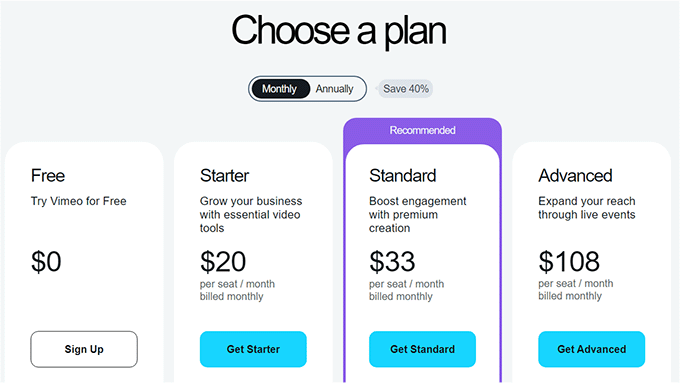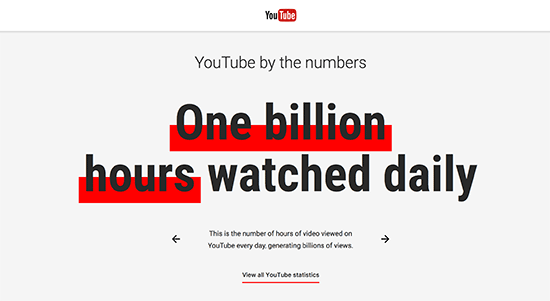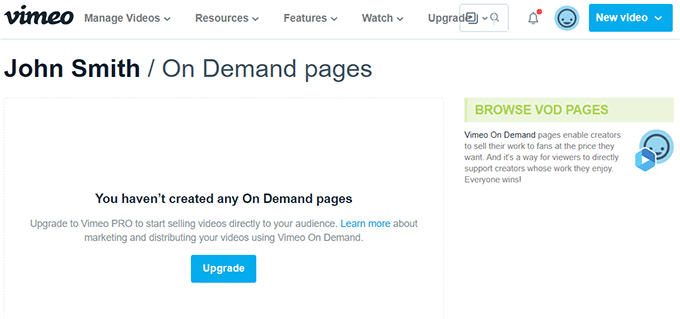Digital Marketing, Social Media
What’s Better for WordPress Videos: YouTube or Vimeo?

Video dominates the internet. You can hardly use a search engine without seeing some video results. News articles have little written content and a lot of linked videos. And if you’re on any social media platform, your feed is probably full of video clips and excerpts from TV series or movies. WordPress videos are a great way to engage your audience, boost your SEO, and increase conversions. But when it comes to choosing a video hosting platform, there are two main options: YouTube and Vimeo.
YouTube is the world’s most popular video hosting platform, with over 2 billion active users. It’s free to use and easy to set up. However, YouTube can be a bit cluttered and crowded, and it may not be the best choice for businesses that want to control their branding.
Vimeo is a more premium video hosting platform, with a focus on quality and design. It’s not as popular as YouTube, but it’s a great choice for businesses that want a more professional look and feel.
If you’re looking to enhance the visual appeal of your videos, consider using tools like FlexClip, which allows you to add professional touches to your content, making it stand out on both YouTube and Vimeo.
The choice between YouTube and Vimeo depends on your specific needs and preferences. If you’re looking for a free and easy-to-use platform, then YouTube is a great option. If you’re looking for a more premium platform with a focus on quality and design, then Vimeo is a better choice.
No matter which platform you choose, make sure that you embed your videos in a way that is optimized for WordPress video. This will ensure that your videos load quickly and look great on your website.
Why use YouTube or Vimeo for WordPress videos?
WordPress is the most widely used blogging platform that professionals suggest using if you want to launch a blog. WordPress is not meant for video streaming, even though you can upload your videos straight there.
Since videos are big files, most WordPress hosting companies don’t have servers that are optimized for video streaming. A server crash may occur if multiple people view the videos on your website at the same time. Additionally, every user has a unique kind of internet connection. Uploading your top-notch videos will require
Conversely, websites like Vimeo and YouTube that host videos are made to provide videos. They can provide a far better video streaming experience than WordPress because they have the server’s resources and technologies at their disposal.
Above all, these videos are simple to embed in WordPress. Here are some factors to consider for both platforms:
Pricing
Vimeo and YouTube are both successful platforms. Their pricing options are based on the revenue streams they generate from the internet.
YouTube
There is a free subscription on YouTube that offers limitless bandwidth and storage.
This is so because YouTube’s primary source of revenue is the display of ads on the site. These advertisements can be shown throughout the YouTube app, sidebar, and video player.
With the free plan, you, as a content creator, can upload an unlimited number of YouTube videos. On your channel, you can even conduct live YouTube broadcasts.
It does have certain restrictions, though, such as not allowing you to submit videos longer than 15 minutes or to monetize them with advertisements.
Additionally, users can subscribe to YouTube Red for a fee. With this service, users may see YouTube’s original series and avoid advertisements.

Users who wish to enjoy video downloads, ad-free viewing, and other features can also purchase a YouTube Premium subscription. Monthly premium subscriptions begin at $13.99.
Vimeo
Vimeo earns money by providing WordPress video hosting services, which sets it apart from YouTube in terms of business strategy. This makes it possible for publishers and small companies to provide their customers with an ad-free viewing experience.
You can utilize Vimeo’s free plan as well. However, the weekly storage is restricted to 500 MB, and you can only generate up to 2 videos every month (a total of 25 videos).
If you’d like access to additional features, you may also sign up for Vimeo’s Starter, Standard, or Advanced plans.

You can begin by using Vimeo Plus, which offers 5 GB of storage each week for $7 a month.
Upload limits
Regarding the quantity of video content you can upload, both platforms have different regulations.
YouTube
By default, you are allowed to post infinite videos, but they must all be shorter than fifteen minutes. You can submit videos with up to 12 hours of playback or a file size of 128 GB, though, after verifying your account.
This is quite realistic and generous for all kinds of content creators.
Vimeo
Each plan on Vimeo has a distinct upload size limit.
- Free: up to 25 GB annually or 500 MB weekly.
- Additionally, 5 GB per week up to 250 GB annually
- Benefits: 20 GB weekly and up to 1 TB annually
- Business: up to 5 TB of total storage with no weekly restrictions
You may view a thorough comparison of every Vimeo plan This implies that the Vimeo upload cap will vary based on the video pricing plan you select.
Audience Size and Reach
Both platforms include social elements baked into their software, devoted communities, and WordPress video sharing capabilities.
YouTube
YouTube has a distinct edge in terms of audience numbers and reach.

Since Google owns it, all of its other products feature it more prominently. Pre-installed on nearly every Android phone around the globe is the YouTube app.
Almost one-third of all internet users, or over a billion individuals, utilize YouTube. In addition, it is the second-most popular search engine globally.
Vimeo
Compared to YouTube, Vimeo has far fewer subscribers (1.9 million) and approximately 260 million monthly views.
Despite its rapid expansion, the platform is trusted by 287 million creatives, organizations, and entrepreneurs worldwide.

There are more options available on Vimeo that might expand the audience for your channel. Its search function, for instance, enables users to look for videos, individuals, channels, and groups.
Moreover, it contains a feature called content discovery that displays related videos or WordPress videos in the sidebar. They are not as obvious as they are on YouTube, though, by design.
Similar to this, Vimeo allows users to form and be a part of groups with its Groups feature.
Privacy Control
Not every publisher desires for all users to see their stuff. For instance, you might want to limit video access to paying users exclusively if you run a membership site or provide online courses.
Let’s examine how publishers might manage the privacy of their movies using these two technologies.
YouTube
There are three privacy options available on YouTube for the videos you upload.
Private: Only you and the specific users you designate can see these videos.
Public: These films are available to everyone. The YouTube platform allows for the ability to search, list, and view them.
Unlisted: These films are accessible to anybody with an address URL. It won’t, however, show up in related videos or YouTube searches.

In addition to these options, you also have the option to remove comments from your videos. You can choose on YouTube to prohibit others from embedding your videos on other websites, but doing so will also stop anyone from doing so on WordPress websites.
If you wish to host private videos, YouTube is not the best place.
Vimeo
Vimeo outperforms YouTube in terms of privacy protections. You can use it to conceal your films on Vimeo and set them to private, public, or unlisted.
This implies that although your film won’t have a Vimeo homepage, it may be embedded and viewed on your WordPress website.

You can limit video embeds to your website exclusively if you are on a subscription plan. You may also make your videos password-protected so that only individuals who know the password can watch and share them.
After that, you can include those movies in password-protected WordPress posts.
Vimeo is a far superior option if you want more control over who can view your online videos.
Video Editing
Both platforms offer excellent tools for posting, editing, and managing WordPress videos.
YouTube
YouTube has robust tools for modifying videos. With their video editor, which they provide, you may make videos using already uploaded footage, images, titles, and more.

Additionally, you may use Google Photos to create films using your images and WordPress videos. A quick and easy way to create videos is with web-based video editing software.
You can also add links, subtitles, and captions to your videos on YouTube. Additionally, it has a live streaming option that lets you watch news, events, or just informal vlogs.
Vimeo
Compared to YouTube, Vimeo does not provide as many options for video editing. It does, however, include all the necessities.
Titles, descriptions, categories, tags, licenses, and audience ratings can all be added to videos. You have the option to add subtitles and captions to your videos.
Nevertheless, Vimeo lacks annotation capabilities, so you are unable to include clickable links in your films.
Additional editing tools offered by Vimeo include text overlays, transition effects, screen cards, audio effects, curve editing, unique watermarks, color correction and grading, and video cutting and cropping.
Vimeo’s biggest feature is that you can even switch out your old video with a new one without affecting the video’s URL or statistics.
Monetization Option
Users of both platforms can monetize their WordPress videos online. Let’s examine the monetization alternatives of Vimeo and YouTube.
YouTube
To monetize their videos, YouTube partners with content providers that sign up for Google AdSense. Then, the advertisements that appear on their films are divided up among the creators.
To join the program, you must first meet the following requirements: You must be at least eighteen (18) years old, have 4,000 watch hours during the last 12 months, and have 1,000 subscribers on your YouTube channel.

Content producers can employ additional revenue streams on YouTube.
Publishers can, for instance, solicit donations, include sponsored reviews, join affiliate networks, sell goods in their films, and more.
A large number of the most well-known content producers on YouTube also use Patreon and other similar websites, where fans may donate directly to support their channels.
Vimeo
Vimeo does not have an advertising program that you may join to earn money; instead, they take pride in providing an ad-free video platform.
They do, however, have a function called “Vimeo on Demand” that lets you sell films to customers directly. To participate in the program, you must have at least a Vimeo Pro account.

In a similar vein, you can design and market membership packages that grant users access to premium features like first access to new movies, behind-the-scenes tours, and retail discounts.
You may also hold live events that people can pay to view, such as webinars, concerts, and workshops, using Vimeo.
Including links in the descriptions of your Vimeo films, mentioning sponsors in them, and encouraging viewers to subscribe to your channel on Patreon are all additional ways to monetize your content.
Who comes out on top?
Both Vimeo and YouTube are excellent, user-friendly platforms for hosting WordPress videos. They provide fantastic tools for editing movies, simplify the process of embedding films on your website, and even offer numerous opportunities for earning money online.
YouTube will be more beneficial for your objectives if you are a small business owner or have recently launched a WordPress site and wish to use videos to expand your audience and gain subscribers.
However, you will require additional privacy and an excellent viewing experience if you run a membership-based website, sell courses, or host webinars or live events. Vimeo is a better option at that point.